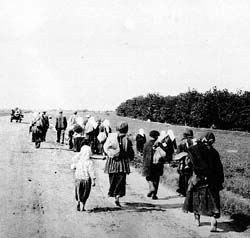Mykolaiv region opening its archives
Books based on facts about the Holodomor in southern Ukraine
A few days ago the Mykolaiv Scholarly Pedagogical Library held a launch of two books: The Mykolaiv Region in the Starving Years of 1921-1923, 1932-1933 and 1946-1947 and the third volume of Rehabilitated by History: the Mykolaiv Region. The first book was co-written by Mykola Shytiuk, a well-known historian of the southern regions of Ukraine during the period of totalitarianism, who heads the Mykolaiv Training and Research Institute at Mechnikov Odesa National University, and Kyrylo Horburov, Candidate of Historical Sciences. Based on materials from previously closed collections of state and departmental archives, their work explores the causes, tragic process, and economic, national, and demographic consequences of the 20th-century Holodomors in the Mykolaiv region. As Dr. Shytiuk noted, the simultaneous launch of the two books is symbolic, as their topics are related. “The years 1932-33 were a horrible time for Ukraine. It was the period of both the Holodomor and political repressions. This was a time when thousands of innocent victims died as a result of the criminal activities of the communist Soviet authorities,” he said.
According to Dr. Shytiuk, the book about the famine in the Mykolaiv region is the first complete work of research on this topic. A group of authors, who will write a more detailed study, has already been formed. Supported by Oleksii Harkusha, the head of the Mykolaiv Regional State Administration, they plan to write a three-volume study, each book of which will be devoted to a particular Holodomor period: 1921-23, 1932-33, and 1946-47.
Larysa Shevchenko, director of the State Archive of Mykolaiv Oblast, recounted the history of a unique document that was discovered in an archive in Odesa. This is an official act dated April 1934 and marked “Secret,” which was sent to every local authority. The document contains an order to eliminate all the 1932 and 1933 death records in every populated area. It is clear now why no one can determine the exact number of Holodomor victims in Ukraine as a whole, and in the Mykolaiv region in particular.
Speaking about the second book, Oleh Bazhan, a senior scholarly associate of the Institute of Ukrainian History at the National Academy of Sciences of Ukraine, noted that Mykolaiv oblast is the first region in Ukraine to publish a book spanning the period from 1953 to the 1980s. The authors faced a number of problems, such as the diverse character of the opposition movement, the debatable character of the definitions of such notions as “opposition member” and “dissident,” and the relatively limited number of general studies and information sources. However, the authors were able to make extensive use of memoirs written by eyewitnesses and surviving victims.
In addition to researching individual criminal cases located in the archive of the Mykolaiv regional branch of the Security Service of Ukraine and the Mykolaiv Regional Archive, the authors were the first to use materials from the archive of the regional Court of Appeals and Mykolaiv district courts. As a result, the reader can read about outright resistance to the official Soviet ideology, quite a number of cases of individuals promoting the ideas of national liberation, and examples of religious conflicts with the Soviet-communist totalitarian machine.






